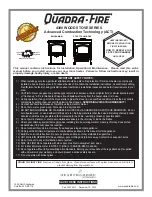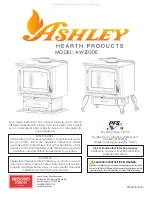
Matrix Insert Installation and Operation Manual
24 ______________________________________________________________________________
5.4.5
LOGS ORIENTATION
In a relatively square firebox, the wood can be loaded north-south (ends of the logs visible) oreast-
west (sides of the logs visible).
North-south loads allow more wood to be loaded at the same time. On the other hand, they break
into smaller pieces faster. North-south loading is good for high output, long lasting fires for cold
weather.
East-west loads allow a limited amount of wood since too many logs could cause them to fall on
the glass. East-west loads, placed in a compact way, take a long time before breaking down. They
are excellent for low-intensity, long-lasting fires in relatively mild weather.
6
MAINTAINING THE WOOD HEATING SYSTEM
6.1
INSERT MAINTENANCE
This insert will give many years of reliable service if used and maintained properly. Some of the
internal components of the firebox, such as firebricks, baffle and air tubes will wear over time
under intense heat. Defective parts should always be replaced with original parts. See «
Appendix
7: Exploded Diagram and Parts List
». Firing each load hot to begin a cycle as described above will
not cause premature deterioration of the insert. However, letting the insert run with the air intake
fully open for entire burn cycles can cause damage over time. The hotter the insert becomes
throughout burn cycles, the more quickly its components will deteriorate. For this reason,
the
insert should never be left unattended while a new load is being fired hot.
6.1.1
CLEANING DOOR GLASS
Under normal conditions, your door glass should stay relatively clear. If your firewood is dry
enough and you follow the operating instructions in this manual, a whitish, dusty deposit will form
on the inside of the glass after a week or so of use. This is normal and can be easily removed when
the insert is cool by wiping with a damp cloth or paper towel and then drying.
Never try to clean
the glass when the insert is hot.
In spring and fall when the insert runs at lower temperatures, light brown stains may form,
especially in the lower corners of the glass. This indicates that the fire has been smoky and some
of the smoke has condensed on the glass. It also indicates incomplete combustion of the wood,
which also means more smoke emissions and faster formation of creosote in the chimney. The
deposits that form on the glass are the best indication of the fuel quality and success in properly
using the insert.
The goal should be having a clear glass with no brown stains. If brown stains appear regularly on
the glass, something about the fuel or the operating procedure needs to be changed.
These stains can be cleaned with a special wood insert glass cleaner. Do not use abrasives to clean
the insert glass. When the weather is mild, it is often better to let the fire go out than trying to
maintain a continuous fire. Use the technique described in section «
5.4.1 Small Fires to Take the
Chill Off the House».
















































